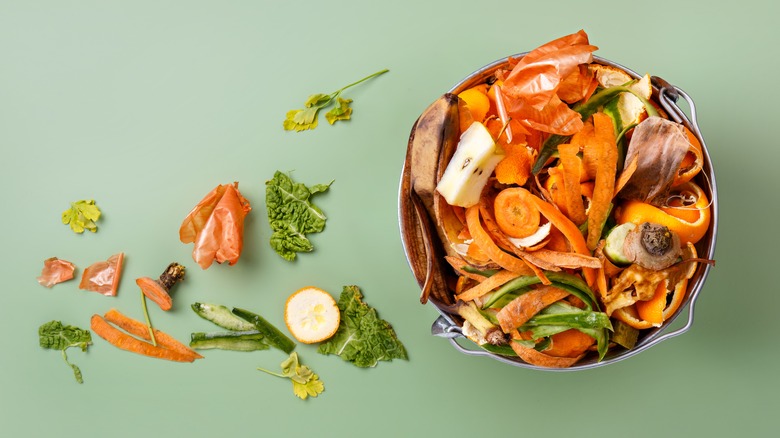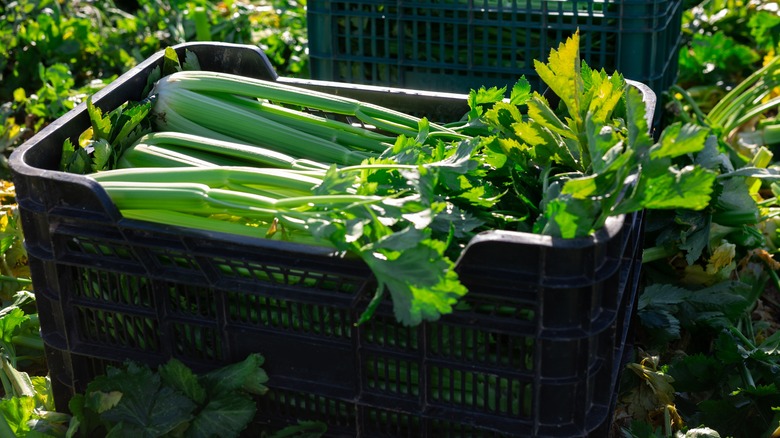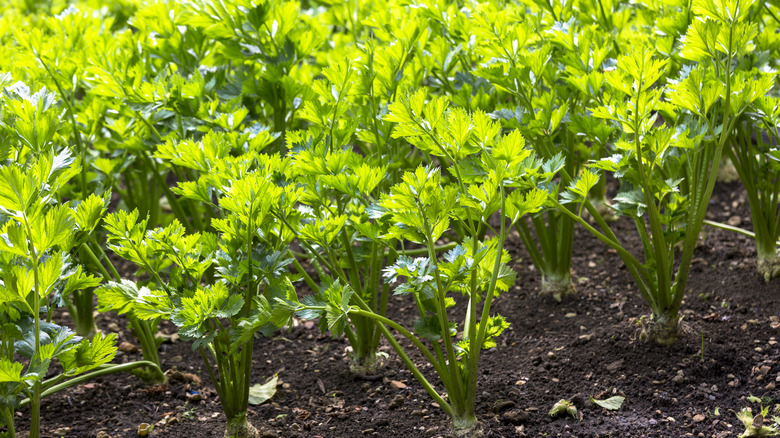Why You Should Add Celery Leaves To Your Salad
Food waste is a really big deal. Over a billion tons of edible food is wasted globally each year, reports the Food and Agriculture Organization of the United Nations – contributing to a massive carbon footprint. Seasonally, The Atlantic reminds us that over a billion pounds of pumpkins are tossed every year in the wake of Halloween — startling stats coming from a society obsessed with pumpkin-spiced everything. And more wastage comes like clockwork with all the food-centric festivities of the holiday season, per the United States Environmental Protection Agency.
A quick and easy way to start throwing away less food is to begin using more of it. Composting has many virtues, but plenty of the food scraps that go into the pile or the bin can be put to work in the kitchen instead. Keeping the peels on fruits and potatoes means more nutrients in the final dish, says Healthline, and it adds depth to the texture of dishes like soups, mashed potatoes, and applesauce, according to The Washington Post.
Meanwhile, the hardy stems of vegetables like kale, chard, and broccoli make excellent pickles, suggests NYT Cooking, and many produce scraps can find new purpose in soups, stocks, and even salads. Among the most underappreciated of these remnants that you probably have at home right now are celery leaves.
What celery leaves bring to the table
Let's consider a humble stalk of celery. Most people chop the leafy top and pale bottom end off, or forgo that entirely and buy pre-cut celery hearts — the tenderest, least bitter part, according to produce company Foxy. But instead of tossing those celery leaves in the trash, try them tossed into your next salad.
While celery stalks are renowned for their hydrating properties, per WebMD, and a crunch factor so legit it's used for movie sound effects, according to Atlas Obscura, their flavor is pretty mild. Celery leaves, on the other hand, deliver a more concentrated celery taste, according to the Washington Post. They're soft and palatable, without tough stems like carrot fronds, as FoodPrint describes.
Most importantly, celery leaves are completely edible — unlike the mildly toxic leaves of tomatoes and several other commonly-encountered plant parts, per Farmer's Advance. WebMD reports that celery on the whole is high in vitamin A, vitamin K, folate, and antioxidants, and Livestrong reveals that the leaves specifically are the opposite of poisonous, instead providing a good source of calcium, vitamin E, and fiber.
Celery leaves are a chef's friend
In cooking applications, celery leaves are user-friendly, requiring less chopping leverage than the stalks. They're naturally bite-sized and ready to join lettuce, spinach, radicchio, and the other leafy components of a typical spring mix. Also, if you've ever made a salad without a spinner, or just let your salad sit for a while, you'll notice that due to gravity the heavier ingredients wind up on the bottom of the bowl and you'll have to mix everything up again to even the ratio. Light and manageable celery leaves won't betray you like that. Just remember to make sure your celery leaves and other greens are dry before adding salad dressing, or it won't coat the salad properly, cautions Epicurious.
Celery leaves are also a good choice, like other leafy greens, for an edible garnish, which elevates the look and taste of the dish, according to Leaf TV. So save the celery sticks as a crunchy snack with nut butter or cream cheese, use the root ends in stock or soup, and crown your next salad with the delicate leaves. With such a wide range of culinary applications, celery truly is a versatile mascot for food waste reduction.


